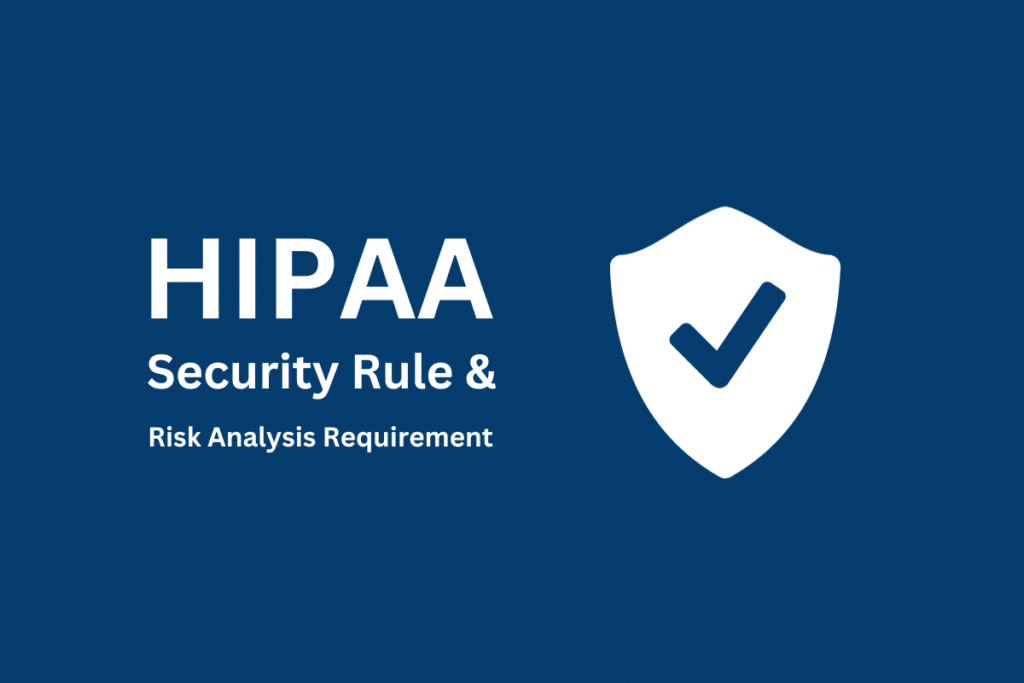HIPAA was enacted by the US government in 1996 to protect patients’ health records by bounding organizations to keep them private and safe. HIPAA has two main parts: the Privacy Rule and the Security Rule.
The Security Rule focuses on electronic health records or ePHI. It tells hospitals, doctors, and health apps how to keep this digital info safe.
In this post, we will discuss the HIPAA Security Rule in detail and will also shed some light on how to implement the HIPAA Risk Analysis requirement.
Understanding the HIPAA Security Rule
The HIPAA Security Rule governs the use and protection of electronic protected health information (ePHI), a subset of protected health information (PHI) which includes 18 different types of personal data such as:
- Patient Names
- Geographical Elements (ZIP codes, street, city, county)
- Important Dates (e.g., birthday or the day they were admitted to a hospital)
- Telephone Numbers
- Fax Numbers
- Email Addresses
- Social Security Numbers
- Medical Record Numbers
- Health Insurance Beneficiary Numbers
- Account Numbers
- Certificate/License Numbers
- Vehicle Identifiers
- Device Identifiers or Serial Numbers
- Digital Identifiers
- IP Addresses
- Biometric Elements
- Full Face Photographic Images
- Other Identifying Numbers or Codes
The HIPAA Security Rule applies to groups called covered entities and business associates.
Covered Entities are organizations like healthcare providers, doctors who send personal health information electronically, and others.
Business Associates are the companies or people who work with these covered entities, known as business associates. They must have an agreement, known as a Business Associate Agreement (BAA), which clearly says how they will protect the ePHI.
Key Provisions of the HIPAA Security Rule
Administrative Safeguards
- Security Management Process: Prioritize identifying and analyzing potential risks to e-PHI. Implement measures to reduce vulnerabilities to a reasonable level to prevent and correct security violations.
- Assigned Security Responsibility: Designate a security official who will oversee the development and implementation of security policies and procedures. This individual could take on the roles of both the security and privacy officer, spearheading the initiative to safeguard the organization against breaches in data security.
- Workforce Training and Management: It is vital to train all members of your workforce on the established security policies and procedures. Ensure appropriate sanctions are in place for members who violate these policies and make sure your employees know them.
- Information Access Management: Establish policies that authorize access to e-PHI based on the role of the user or recipient, ensuring that unauthorized intrusion is blocked. Here’s what you need to implement:
- Role-Based Access
- Minimum Necessary Access
- User Authorization
- Security Awareness Training: Develop a comprehensive cybersecurity training program for employees to foster an environment of vigilance and responsibility in enforcing the HIPAA Security Rule.
- Evaluation: Regularly evaluate the efficacy of your security policies and procedures, adjusting as necessary to meet the requirements of the Security Rule.
Physical Safeguards
- Facility Access and Control: Implement stringent physical measures to restrict physical access to facilities while permitting authorized access, employing methods such as:
- Door locks
- Security officers
- Video monitoring.
- Workstation and Device Security: Establish policies that dictate the appropriate use and access to workstations and electronic media. Outline procedures for the transfer, removal, disposal, and reuse of electronic media storing e-PHI to prevent unauthorized access.
Technical Safeguards
- Access and Audit Controls: Develop technical policies that only permit access to e-PHI by authorized persons or software programs. Implement mechanisms to record and scrutinize access and activity in information systems containing e-PHI such as:
- Activity Logs
- System Monitoring
- Incident Reporting
- Authentication and Integrity Controls: Put in place measures that verify user identities to control access to ePHI.
- Transmission Security: Safeguard e-PHI during transmission through encryption and integrity controls, ensuring the data remains protected against unauthorized access and alterations.
The Role of A Risk Analysis in HIPAA Compliance
A HIPAA Risk analysis is the process in which healthcare organizations closely examine their systems to find any weaknesses or loopholes where ePHI might be accessed, altered, or stolen by people who aren’t supposed to have access.
A risk analysis plays a critical role in following the HIPAA Privacy Rule because it helps these organizations identify potential privacy problems early on. It’s an ongoing task, ensuring that defenses are always up-to-date and strong enough to keep information safe and secure.
These are the objectives of a HIPAA Risk Analysis:
- Identify potential vulnerabilities where ePHI (Electronic Protected Health Information) can be accessed unauthorizedly.
- Pinpoint areas where the current security measures might be insufficient.
- Develop strategies to safeguard against unauthorized access or data breaches.
- Comply with legal requirements to avoid penalties and maintain a trustworthy reputation.
- Enhance the overall security infrastructure by constantly updating protective measures based on the analysis outcomes.
- Ensure confidentiality, integrity, and availability of ePHI by implementing strong defense mechanisms.
- Educate and train staff on the importance of securing ePHI and the role they play in its protection.
- Foster a proactive approach to data security, preparing for potential threats before they occur.
- Create a responsive plan to manage and mitigate the effects of data breaches, should they occur.
HIPAA Risk Management vs. Risk Assessment
| Aspect | HIPAA Risk Analysis | HIPAA Risk Management |
| Definition | Assessment of risks and vulnerabilities affecting the safety of e-PHI. | Implementation of security measures to reduce risks identified in the analysis. |
| Focus | Identifying potential issues affecting confidentiality, integrity, and availability of e-PHI. | Implementing strategies and plans to safeguard e-PHI. |
| Components | 1) Inventory of systems and applications where data is accessed and housed.
2) Classification of systems by risk level. |
1) Implementation of security measures. 2) Meeting general security standards. |
| Objective | To foresee and quantify potential losses or damages if security measures were not in place. | To prevent data loss or compromise through active safeguarding measures. |
| Outcomes | 1) Understanding of vulnerabilities. 2) Identification of potential loss or damage ramifications. |
1) Reduced risk of e-PHI loss or compromise. 2) Compliance with legal security standards. |
How to Conduct a HIPAA Risk Analysis
- Define the Scope: Clearly outline the areas that will be analyzed. This includes all the systems, applications, and network segments in your health organization where e-PHI is stored, accessed, or transmitted.
- Gather Necessary Data: Collect all the relevant data, which would help in identifying where the e-PHI is being used and how it is being transmitted. This includes understanding the workflows and processes involved in the handling of e-PHI.
- Identify Potential Threats and Vulnerabilities: List down all the possible threats like cyber-attacks, natural disasters, etc., and vulnerabilities such as system bugs or weak passwords that could pose a risk to the e-PHI.
- Assess Current Security Measures: Review the existing security measures in place to protect e-PHI. This includes evaluating both technical and non-technical safeguards.
- Determine the Likelihood and Impact of Threat Occurrence: Assess the probability of potential risks happening and the impact it would have on the organization. This step involves classifying risks based on their likelihood of occurrence and the severity of the potential impact.
- Calculate the Level of Risk: Using the information gathered, determine the levels of risk for each threat and vulnerability combination. This can be done using a risk matrix to categorize risks as low, medium, or high.
- Develop a Risk Management Plan: Based on the analysis, create a comprehensive risk management plan. This plan should detail the strategies and measures to mitigate identified risks.
- Document the Analysis: Properly document all the steps of the risk analysis, including the findings and the decisions made during the process.
- Implement the Risk Management Plan: Execute the strategies outlined in the risk management plan to mitigate the risks identified.
Challenges and Best Practices in HIPAA Risk Analysis
Here are some of the challenges faced by healthcare organizations when conducting a HIPAA Risk Assessment:
Lack of Clarity on Where to Start
Solution: Begin by identifying areas where e-PHI is stored and processed. Break down the process into smaller parts and tackle one segment at a time.
Overwhelming Amount of Data
Solution: Use data sorting and filtering tools to manage the data efficiently. Focus on the most critical data first, then move to the less sensitive information.
Inadequate Staff Training
Solution: Arrange regular training sessions for staff to educate them on the importance of HIPAA compliance and the role they play in maintaining it.
Technical Glitches and System Failures
Solution: Have a robust IT support system in place that can quickly address and fix technical issues. Regular maintenance and system updates are crucial.
HIPAA Compliance and Risk Analysis Tools
Below, we highlight some of the essential tools that can aid organizations in this regard:
- Data Encryption Tools: These tools help in securing e-PHI by encrypting the data during transmission and storage, making it inaccessible to unauthorized users.
- Firewalls and Anti-Malware Software: Protect your systems from external threats and malicious software by setting up robust firewalls and installing up-to-date anti-malware software.
- Access Control Systems: These systems allow you to restrict access to sensitive information, granting permissions only to authorized personnel, thereby minimizing the risk of data breaches.
- Audit Trail Software: This software helps in tracking all the activities within the system, providing a detailed log that can be reviewed to identify any unauthorized or suspicious activity.
- Data Backup Solutions: Implement solutions that regularly back up data, ensuring that information can be restored in case of data loss or system failure.
- HIPAA Compliance Software: These solutions assist in implementing HIPAA controls and developing privacy policies, and much more.
- Training and Awareness Programs: Develop programs to educate employees about the best practices and protocols for maintaining HIPAA compliance.
The advancement in technology has paved the way for tools that can streamline HIPAA compliance, making it simpler and cost-effective.
One such tool is MedStack.
Where the traditional route can take a considerable amount of time and resources, MedStack expedites HIPAA compliance, turning months of work into just several weeks.
Final Thoughts
Ready to make your HIPAA compliance journey smooth and straightforward? With MedStack, you’re not just getting a service; you’re adopting a partner that genuinely understands your needs. Don’t let compliance be a roadblock to your success.
Contact MedStack and find out how you can transform the way you approach HIPAA compliance without the fuss.




